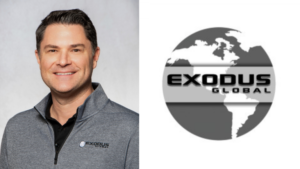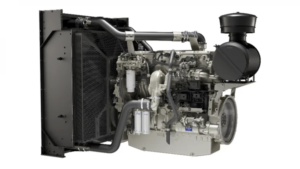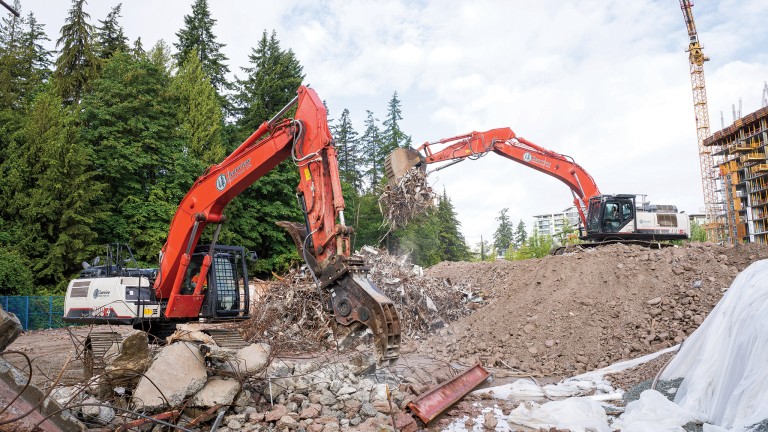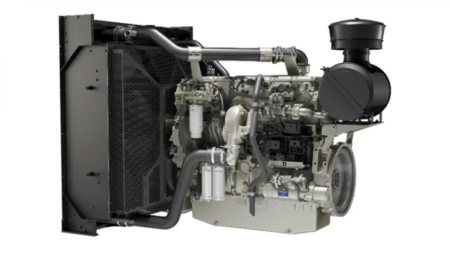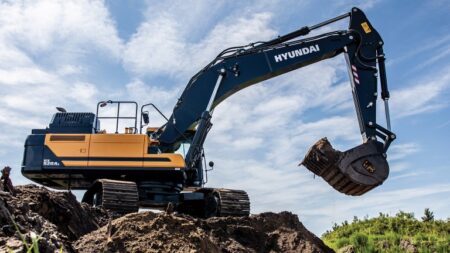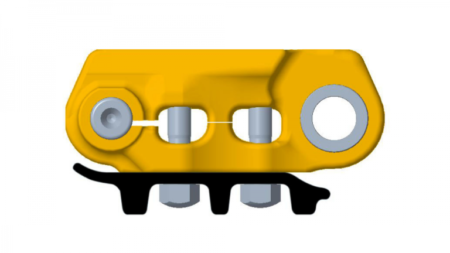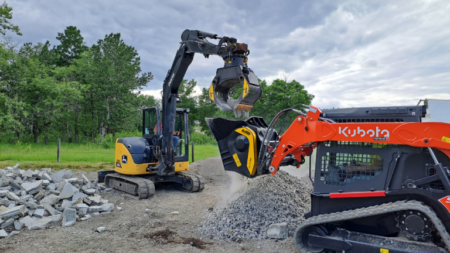The Link-Belt 245 zero-tail-swing machine was ideal for the select demolition of homes on a land redevelopment project where preserving adjacent structures was essential.
Mack Plovie
The Clearview Demolition story
Clearview Demolition Ltd has a long history of demolishing buildings in B.C.; however, the company didn’t start with demolition. The company was originally incorporated in 2006 as Clearview Grinding, a new venture for Mike Lalonde, who owned Blue Pine Enterprises, a company focused on land clearing, mulching, and grinding with a handful of excavators. In 2008, Brad Morrison (a friend of Lalonde’s since Jr. High) joined the Clearview Grinding team to shift the company’s focus in a new direction: demolition.
Clearview Grinding’s first large project was to demolish a large plot of houses for BC Housing. Once abatement had been completed, Clearview Grinding used a Morbark 4600 grinder to grind up all wood on site, recovering 96 percent of the material. Clearview Grinding was the first company to use a grinder for this type of project, reducing waste sent to landfills; ground materials were sold as fuel.
As the company continued to grow, taking on other demolition projects, the name was changed to Clearview Demolition. Clearview Demolition was soon working on bridge, high rise, and pulp mill demolition projects; the company purchased a mobile crusher for concrete recycling and later acquired excavator-mounted shears to recycle steel. Clearview Demolition’s first large project, a pulp and paper mill in Prince Rupert, required the complete demolition and recycling of the mill facility and surrounding infrastructure.
“Once you get a few of those projects under your belt, you get to be known as the guys,” says Morrison, now general manager of Clearview Demolition.
The company acquired its first high-reach excavator, originally spotted at a 2010 demolition conference in Las Vegas, in 2013 out of California. Adding the first high-reach machine to its fleet helped Clearview take on projects like a 10-storey high-rise project in Richmond and a building fire demolition project on Granville Street in Vancouver. The high-reach machine proved advantageous, as it could be positioned in the parking lot to preserve the building’s concrete slab.
Today Clearview Demolition has over 60 employees, 60+ pieces of heavy equipment, and is solely focused on industrial, commercial, and residential demolition across Canada. And, Morrison notes, “We focus on one thing, and we are very good at it.”
Clearview’s sister company, Blue Pine Enterprises, still operates and focuses on commercial landscaping, specializing in lock block walls and detail work.
Clearview grows its fleet with a variety of Link-Belt machines
Clearview’s fleet of equipment has expanded as the company has grown in the demolition space. Clearview has owned multiple brands of equipment, but now acquires primarily Link-Belt excavators and operates the largest Link-Belt excavator fleet in Western Canada, with 17 machines.
Clearview purchased its first two Link-Belt 350 excavators in 2019. “We were looking to try something different, we tested a few machines side by side, the Link-Belt price point was good, comfort was great, and fuel burn was less than other machines,” says Morrison.
The company operates Link-Belt’s 15-metric-ton 145 through to 245, 300, 350, 355, and up to the 490, which weighs in at 52 metric tons.
“Our overall operating costs have dropped. We are not easy on gear, we are hammering concrete, shearing steel, wrecking buildings,” notes Morrison.
Sold and serviced by Inland Truck and Equipment in British Columbia, the expansive Link-Belt product line covers nine conventional sizes from 13 to 75 tons in the construction, forestry, and material handler categories.
LBX Company recently celebrated the 150th anniversary of the Link-Belt brand, which started with the link-belt drive chain patented by William Dana Ewart 1874. The company started building crawler-mounted crane shovels, forerunners of modern excavators in the 1920s. In 1998, the excavator division of Link-Belt Construction Equipment Co., LBX Company, was formed and headquartered in Lexington, Kentucky. Today, Link-Belt excavators are manufactured in Chiba, Japan, and a new manufacturing plant recently opened in Indonesia.
Clearview has equipped each Link-Belt machine with demolition attachments, such as second member shears, pulverizers, hydraulic hammers, grapples, and magnetic buckets. All 17 excavators are set up with rotate hydraulic circuits and dedicated extra hydraulic flow circuits to run second member shears, grapples, and hydraulic hammers.
Clearview currently has second member LaBounty shears on four Link-Belt excavators and a Hitachi machine: a Link-Belt 145 with LaBounty 100, three Link-Belt 350 excavators with LaBounty 2500 shears, and a Hitachi EX800 excavator with a LaBounty 7500.
On Clearview’s newer 2023 Link-Belt 355 X4S excavator, prioritizing the hydraulic energy to swing motor, boom, or stick function is done through the new 10-inch in-cab screen.
“Changing hydraulic prioritization circuits is as simple as pushing a button on the console and selecting what circuit you want to prioritize on the screen,” says Mark Williams, equipment specialist with Inland Truck and Equipment.
Clearview is also looking ahead at configuring a Link-Belt excavator for high-reach applications using a 350 or larger machine as the carrier and customizing it with a third-party high-reach boom and work tool.
Read the full article here

